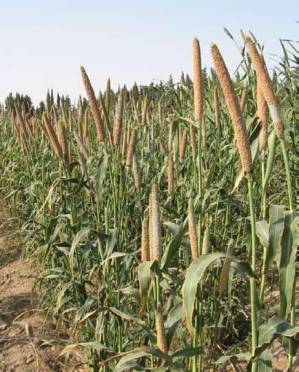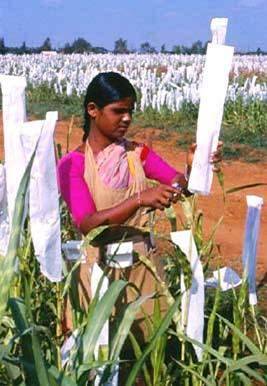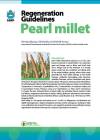Regeneration guidelines for pearl millet
|
View regeneration guidelines in full (in PDF)
Also available in the following languages: |
The information on this page was extracted from:
Upadhyaya H.D., Reddy K.N. and Sastry D.V.S.S.R. 2008. Regeneration guidelines: pearl millet.
In: Dulloo M.E., Thormann I., Jorge M.A. and Hanson J., editors. Crop specific regeneration guidelines [CD-ROM]. CGIAR System-wide Genetic Resource Programme, Rome, Italy. 9 pp.
Before reading the regeneration details for this crop, read the general introduction that gives general guidelines to follow by clicking here.
Introduction
Pearl millet (Pennisetum glaucum (L.) R. Br.), also known as bulrush or cattail millet, is an important grain and forage crop in Africa and South Asia and a forage crop in the Americas. It is mostly grown under hot, dry conditions on infertile soils of low water-holding capacity, where other crops generally fail. Pearl millet belongs to the family Poaceae, subfamily Panicoideae, tribe Paniceae, subtribe Panicinae, section Penicillaria and genus Pennisetum. The genus Pennisetum contains about 140 species. The important wild relatives of cultivated pearl millet include the progenitor, Pennisetum glaucum subsp. monodii Maire; P. purpureum K. Schumach.; P. pedicellatum Trin.; P. orientale Rich.; P. mezianum Leeke; and P. squamulatum Fresen. Previous names are P. typhoideum L.C. Rich. and P. americanum (L.) Leeke. The four cultivated forms of pearl millet are typhoides (found mainly in India and Africa), nnigritarum (dominant in eastern Sahel), globosum (dominant in the western Sahel) and leonis (dominant on the West African coast) (Brunken et al. 1977; Rai et al. 1997; Syngenta 2008).
Pearl millet is a C4 species and grows up to 5 m tall. It is allogamous and landraces are highly heterogeneous. Stigma emergence precedes anther emergence, resulting in high cross-pollination due to wind. Precautions are needed to preclude cross-pollination during regeneration and preserve the genetic integrity of germplasm accessions.
Choice of environment and planting season

Pearl millet growing in the field in Dubai, UAE. |
Climatic conditions
- Pearl millet can grow in a wide range of ecological conditions.
- Low precipitation and relative humidity during seed ripening and maturation are desirable.
- Poor emergence and seedling growth may result if seeds are planted before soil temperatures reach 23°C.
- The optimum annual rainfall is 350–500 mm.
- It can also be grown as an irrigated crop.
Planting season
- Pearl millet is a short-day species and flowers early with short days. Day-length of 12 hours and 28–30°C temperature are suitable for crop growth (Bidinger and Rai 1989).
- Choose time of planting so that flowering and seed development coincide with favourable environmental conditions to facilitate flowering and seed production in all maturity groups.
- If irrigation is available regeneration should be carried out during the off-season (outside the rainy season) when days are short to facilitate flowering and seed production in photosensitive germplasm.
- Under these conditions the incidence of pests and diseases is usually low.
Preparation for regeneration
When to regenerate
- When seed stocks are <50 g.
- When germination falls below 75%.
- When >25% of seeds are infected by one or more fungi, such as Alternaria, Aspergillus, Cladosporium, Curvularia, Fusarium, Macrophomina, Penicillium, Phoma and Rhizopus spp. (Rao and Bramel 2000).
Seed sample
- To maintain genetic integrity use seed from the original source, as far as possible.
- A minimum of 120 plants is required for regeneration.
- A minimum of 9 g seeds is required for regeneration of a germplasm accession.
- Because of small seed size, take care when preparing seed samples.
- Treat the seed with a fungicide to control seed-borne fungi.
- For each accession, prepare one seed packet for planting each row.
- Label the packets with identification number and row number and arrange them according to field lay-out.
Field selection and preparation
- Choose a field that was not under millet during the previous 2 years to reduce risk of volunteer plants and diseases.
- Pearl millet can be grown on a wide variety of soils ranging from clay loams to deep sands but yields and grain quality are best on deep, well-drained productive soils.
- Root development can be severely restricted by soil conditions such as excessively high or low soil moisture levels, hard pan and compaction.
- Pearl millet can tolerate acid subsoils to as low as pH 4 but does not grow well on calcareous soils.
- Cultivate so as to completely bury all crop residues, crop volunteers and weeds.
- Avoid fields infested with witchweed or striga.
- Prepare the land to a fine tilth by deep ploughing fol owed by three or four harrowings.
- Level the field and make ridges 75 cm apart.
Method of regeneration
Pollination
Being mostly allogamous, it is important to properly control cross-pollination by wind and insects to maintain the genetic integrity of individual accessions. Pollination during regeneration can be done in three different ways, namely through cluster bagging, sibbing and selfing. Cluster bagging and sibbing are used for regenerating landraces.
Either method can be used based on the resources and level of genetic integrity which is aimed for. Cluster bagging tends to be more easily implemented and less expensive but has a higher risk of reducing genetic integrity, while sibbing is more labour intensive but can achieve a higher genetic integrity. The sibbing method is followed to maintain male sterile lines (Rao and Bramel 2000). Selfing is principally used to regenerate inbred genetic stocks.
Cluster bagging:
- Cover one panicle each of 2–4 adjacent plants in a row in one parchment paper bag before stigma emergence.
- Staple or put a paper clip holding the corners together so that the bags are not blown off the panicle.
- Pollination occurs among the panicles within the bag.

Bagging panicles during pearl millet (Pennisetum glaucum) regeneration. (photo: ICRISAT) |
Sibbing:
- Cover one individual panicle in one parchment paper bag before anthers begin to dehisce. (see photo)
- Staple or put a paper clip holding the corners together so that the bags are not blown off the panicle.
- After 2–3 days, remove the bags and collect pollen from the matured panicles into a common paper bag by gently tapping the panicles into it and then cover the panicles again with their bags.
- When the stigma have emerged, remove the bags from panicles and dust the collected bulked pollen on to the stigmas of all plants in an accession and cover the panicles with paper bags.
- Mark the date of pollination on the bags.
- Continue the process of pollen collection and dusting for 4–5 days in each accession, depending on panicle length and flowering duration.
- Self the plants that flower very early by covering the panicles in parchment paper bags. If the plants flower very late, pol inate them with pol en col ected from tillers of the early flowering plants. If no til ers are available, self the late- flowering plants too.
- Ensure that all plants within the accession are either sibbed or selfed.
- Remove the bags 2 weeks after flowering (at dough stage) and clasp them around the panicles to identify selfed/sibbed panicles when harvesting (Rao and Bramel 2000).
Selfing:
- Cover individual panicles in parchment paper bags before stigma emergence and staple the bags (see photo).
- Mark the date of covering on the bag.
Planting layout, density and distance
- Divide the field into plots (also known as tiers), with 1 m between them. The plots should be at least 4 m wide, depending on the size of the field.
- Mark rows 75 cm apart across each tier, perpendicular to the length of the field, giving rows of at least 4 m long or more, depending on the width of the plot.
- Assign row numbers in a serpentine pattern (i.e. planting from left to right in the first row followed by right to left in the second row or vice versa).
Planting method
- Plant using a tractor- mounted four-cone planter or sow manually.
- Plant on top of ridges to facilitate good drainage, easy field operations and high soil moisture availability.
Labelling
- Label each accession with a tag fastened to a stake about knee height.
- The tags should be of strong paper to withstand weathering.
Crop management
Weed management
- Spray a pre-emergent herbicide at recommended dose to minimize weeds (Andrews et al. 1993).
- Inter-cultivate 15–20 days and 30–35 days after sowing and put earth around the base of plants after 35–40 days to minimize lodging.
- Depending on number of weeds, hand weed once or twice.
- Weed control is critical around 25–30 days after sowing.
Thinning
- Thin the crop after 15 days to about 120 plants in 1–3 rows.
- Thin again when seedlings are 2–3 weeks old, leaving 10 cm spacing between the plants and a minimum of 40 plants in each row/plot.
Fertilization
- If possible, do a soil test to determine fertilizer needs and apply fertilizer according to recommendation.
- If it is available, apply 6–7.5 t of farmyard manure/ha and incorporate it before last ploughing.
- Apply a basal dose of diammonium phosphate (150 kg/ha) and urea (100 kg/ha) as top dressing 30 days after sowing.
Irrigation
- Apply supplemental irrigation after sowing if the soil is not moist enough; irrigate again if leaves wilt at any stage of crop growth and to ensure enough moisture in the soil at flowering.
- See that the field has proper drainage, as waterlogging damages the crop severely.
Common pests and diseases
Arrange for pathologists and entomologists to visit the field to identify pests and diseases and their control. Major pests and diseases of pearl millet include:
- Downy mildew (Sclerospora graminicola (Sacc.) J. Schröt): chlorosis of plant parts, stunted growth and development of green ears are the main symptoms.
- Smut (Moeszimyces penicillariae (Bref.) Vanky): soil-borne pathogen infects crop at flowering through the stigmas, resulting in large brown sori in place of seeds.
- Ergot (Claviceps fusiformis Loveless): soil-borne pathogen infects crop at flowering through the stigmas, resulting in hard, dark brown to black structures, larger than seed, which protrude from florets in place of grain.
- Rust (Puccinia pennisiti): leaf tissues become necrotic from the distal to the basal parts of the leaf. Infected leaf tissue develops circular hypertrophied lesions, yellow-green in colour with a distinct orange border.
- Head caterpillar (Heliothis albipunctella De Joannis): feeds on panicles causing considerable yield loss.
Pest and disease control
- Seed treatment
- Spray recommended fungicide/insecticide if available
- Cultural practices
- Crop rotation
Harvesting
- Harvest 5–6 weeks after bagging, depending how long the accession takes to reach maturity.
- Determine physiological maturity by a black (dark) spot at the bottom of the grain.
- When the crop matures, the leaves turn yellow and dry, grain is hard and firm.
- Cut the bagged or selfed panicles just below the base — one from each plant, from at least 120 plants per accession.
- Collect the panicles within the plot (accession) into a gunny bag labelled inside and out with tear-off tags.
- Do not harvest diseased plants.
Post-harvest management
- Dry the panicles in shade for a week until the seed moisture content is reduced to 12%.
- Thresh individual panicles by gently beating with sticks and clean the seeds by winnowing.
- Collect equal quantity of seeds from each plant to reconstitute the accession.
- Prevent seed mixtures during threshing and seed handling.
- Collect the seeds in a labelled muslin cloth bag for further drying, preferably at a lower temperature and relative humidity.
- Avoid chemical treatment of seed intended for storage.
- Send representative seed samples for seed health and viability testing.
- Reject seed samples with high percentage (>25%) of infection by seed-borne fungi and less than 75% viability. List such accessions for regeneration in the next season.
- Dry seeds to 8–9% moisture content for medium-term conservation.
- For long-term conservation, dry the seeds to 5–7% moisture content using forced ventilation at 15°C and 15–20% relative humidity (Rao and Bramel 2000).
- If a drying room and forced ventilation facilities are not available, dry seeds to a moisture content of 5–7% with silica gel or another appropriate desiccant.
- Verify the accession identity by comparing seed traits with reference material.
- Pack seeds in moisture impermeable containers for conservation and distribution.
Monitoring accession identity
- Eliminate off-types and plants growing off-row.
- Compare for following traits in characterization data: panicle shape, grain shape, grain colour
- Rogue the plants which are genuine mixtures.
Regeneration of wild species
- Maintain wild species as living plants in properly controlled environments to avoid possible outcrossing of germplasm with related species and the introduction of new weedy species.
- Prepare broad beds 1.5 m wide and 6 m long.
- Germinate the wild species in paper cups and transplant them in the evening, 20 cm apart.
- Cover the panicles in parchment paper bags before stigma emergence to prevent outcrossing and seed loss due to shattering.
- Harvest panicles individually, 5–6 weeks after anthesis.
- Separate the seeds by crushing the florets between hands.
- Clean the seeds and take equal quantities of seed from each plant to reconstitute the accession.
- Prune perennial and rhizomatous species up to 30 cm from ground level during the rainy season to avoid mixing with adjacent accessions.
- Use a sample size of 8–10 plants per accession (Rao and Bramel 2000).
Documentation of information during regeneration
The following information should be collected during regeneration:
- Regeneration site name and map/GPS reference
- Name of collaborator
- Field/plot/nursery/greenhouse reference
- Accession number; population identification
- Source of seed
- Generation or previous multiplication or regeneration (if generation is not known)
- Preparation of planting materials (pre-treatments)
- Sowing date and density
- Field layout used
- Field management details (watering, fertilizer, weeding, pest and disease control, stresses recorded, others)
- Environmental conditions (altitude, precipitation, soil type, others)
- Emergence in the field or greenhouse (number of plants germinated)
- Number of plants established
- Days from sowing to flowering
- Breeding system
- Pollination control method used (method, number of plants pollinated)
- Harvest date and method
- Number of plants harvested
- Quantity of seeds harvested
- Morpho-agronomic traits recorded
- Comparisons with reference materials (record any identification numbers or references of any samples taken from this regeneration plot)
- Post-harvest (describe any relevant procedures).
References and further reading
Andrews DJ, Rajewski JF, Kumar KA. 1993. Pearl millet: New feed grain crop. In: Janick J, Simon JE, editors. New Crops. John Wiley & Sons, Inc, New York, USA. pp. 198–208. Available from: http://www.hort.purdue.edu/newcrop/proceedings1993/v2-198.html. Date accessed: 3 October 2008.
Bidinger FR, Rai KN. 1989. Photoperiodic response of paternal lines and F1 hybrids in pearl millet. Indian Journal of Genetics and Plant Breeding 49:257–264.
Bioversity International, ICRISAT, USDA-NPGS, AICR. 2010. Key access and utilization descriptors for pearl millet genetic resources. Bioversity International, Rome, Italy; International Crops Research Institute for the Semi-Arid Tropics, India; United States Department of Agriculture National Plant Germplasm System, USA; All India Coordinated Research Project on Pearl Millet, India. Available here.
Brunken JN, de Wet JMJ, Harlan JR. 1977. The morphology and domestication of pearl millet. Economic Botany 31:163–174.
Rai KN, Appa Rao S, Reddy KN. 1997. Pearl millet. In: Fuccillo D, Sears L, Stapleton P, editors. Biodiversity in Trust. Conservation and use of plant genetic Resources in CGIAR Centers. Cambridge University Press, Cambridge, UK. pp. 243–258.
Rao NK, Bramel PJ. 2000. Manual of genebank operations and procedures. Technical Manual no. 6. ICRISAT, Patancheru, India.
Syngenta. 2008. What is pearl millet? Available from: http://www.syngentafoundation.org/index.cfm?pageID=193. Date accessed 3 October 2008.
Acknowledgement
These guidelines have been peer reviewed by Kameswara Rao, International Center for Biosaline Agriculture (ICBA), Dubai, UAE.



 Pearl millet
Pearl millet

Leave your comments
Post comment as a guest